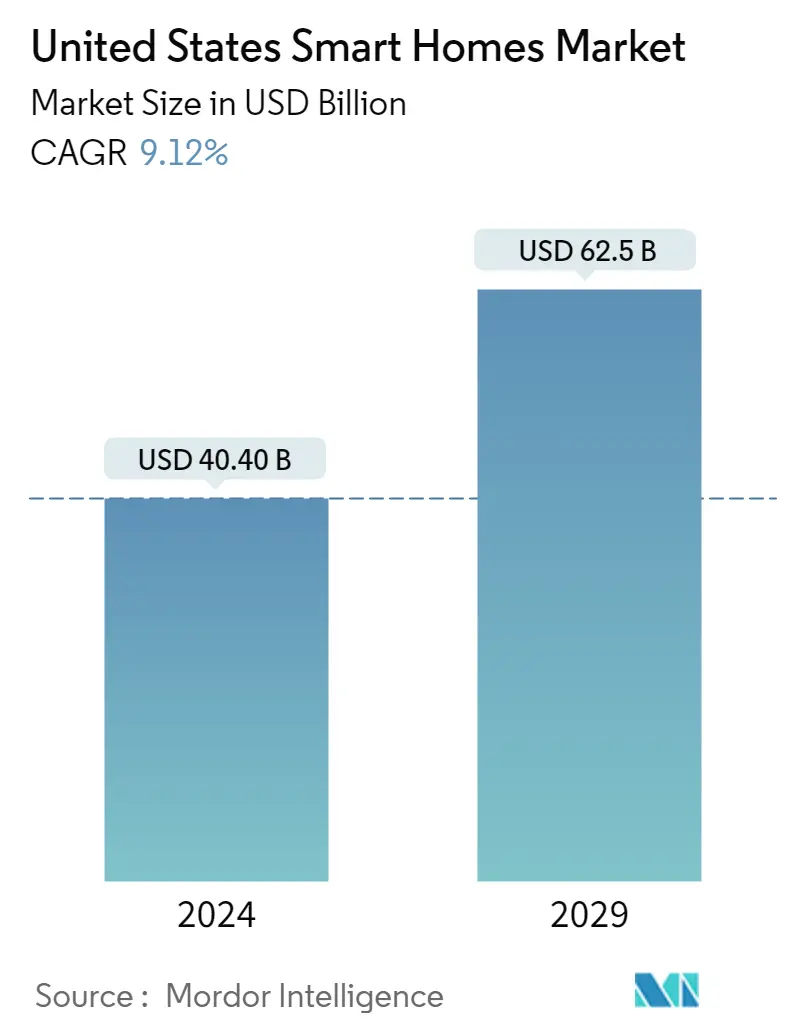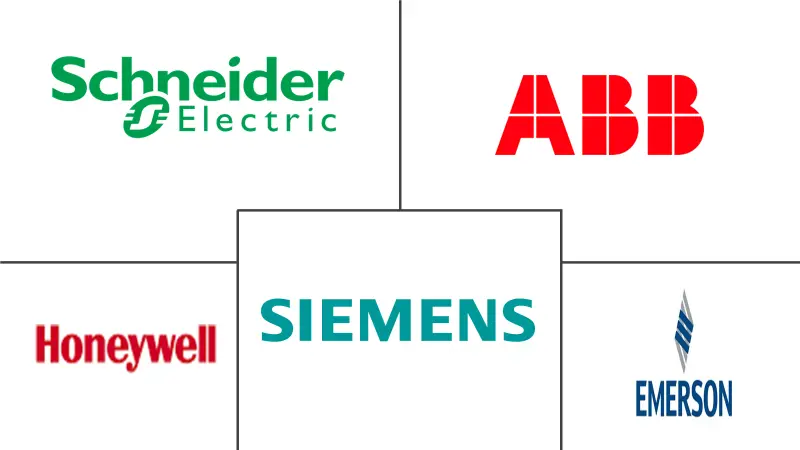Market Size of United States Smart Homes Industry

| Study Period | 2021 - 2029 |
| Base Year For Estimation | 2023 |
| Market Size (2024) | USD 40.40 Billion |
| Market Size (2029) | USD 62.50 Billion |
| CAGR (2024 - 2029) | 9.12 % |
| Market Concentration | Low |
Major Players
*Disclaimer: Major Players sorted in no particular order |
United States Smart Homes Market Analysis
The United States Smart Homes Market size is estimated at USD 40.40 billion in 2024, and is expected to reach USD 62.5 billion by 2029, growing at a CAGR of 9.12% during the forecast period (2024-2029).
Home automation and smart homes are two ambiguous terms used for a wide range of monitoring solutions that control and automate functions in a home. Unlike simple home automation solutions (which could range from motor-operated garage doors to automated security systems), smart home systems require a web portal or a smartphone application as a user interface to interact with a computerized system.
- The increasing importance of the need to counter security issues is anticipated to fuel the demand for smart and connected homes over the forecast period. Moreover, innovative wireless technologies, including security and access regulators, entertainment controls, and HVAC controllers, are expected to foster market growth. The recent advancements in the Internet of Things (IoT), which resulted in price drops for processors and sensors, are expected to encourage manufacturers to promote automation in the household sector.
- In an effort to include more sustainable energy resources, household energy management is receiving a growing level of attention. Further, to reduce their energy costs, homes must become more efficient due to growing energy prices and increased demand. With the help of the Home Energy Management System (HEMS), the enablement of energy management services for effective monitoring and management of electricity generation, power conservation, and energy storage techniques are being developed for smart homes.
- Some smart devices like smart thermostats and their associated apps can assist users in receiving faster alerts when a heating or cooling system is experiencing issues. When a home warms or cools past a preset temperature, some smart thermostats let the user set alarms, potentially signaling system issues. As opposed to using a conventional thermostat, this functionality enables users to schedule service for a damaged or malfunctioning system more rapidly.
- Currently, the smart homes market refers to luxury projects. However, it is expected to become a requirement in all housing categories. The educated population is increasingly migrating to urban areas in search of jobs. With the desire to own a house in sync with the current trends, several people living in urban locations aspire for smart homes or homes that can adapt to evolving technologies. The sector is witnessing prominent growth due to its various advantages. Apart from the luxury segment, homebuyers from multiple components are expected to begin opting for smart homes and their benefits, with home automation being offered at affordable prices.
United States Smart Homes Industry Segmentation
Smart home devices are suitable for a home setup where devices can be automatically controlled remotely from any internet-connected place, using a mobile or other networked device. A smart home has devices connected through the internet, and the customer can regulate functions, such as security access to the house, temperature, lighting, and home theater. The scope of the market includes various smart home segments as below: energy management, comfort and lighting, home entertainment, control and connectivity, security, and smart appliances.
The United States smart home market is segmented by product type (comfort and lighting, control and connectivity, energy management, home entertainment, security, and smart appliances).
The market sizes and forecasts are provided in terms of value (USD million) for all the above segments.
| By Product Type | |
| Comfort and Lighting | |
| Control and Connectivity | |
| Energy Management | |
| Home Entertainment | |
| Security | |
| Smart Appliances |
United States Smart Homes Market Size Summary
The smart homes market in the United States is poised for significant growth, driven by the increasing demand for home automation and security solutions. This market encompasses a wide range of technologies that enable homeowners to control and monitor various functions within their homes through web portals or smartphone applications. The integration of innovative wireless technologies, such as security systems, entertainment controls, and HVAC regulators, is expected to propel market expansion. Additionally, advancements in the Internet of Things (IoT) have led to cost reductions in processors and sensors, encouraging manufacturers to promote smart home solutions. The growing focus on energy efficiency and sustainability, supported by Home Energy Management Systems (HEMS), is also contributing to the market's development, as homeowners seek to reduce energy costs amid rising prices.
The competitive landscape of the US smart home market is characterized by fragmentation, with key players like ABB Limited, Schneider Electric SE, Honeywell International Inc., Emerson Electric Co., and Siemens AG leading the charge. These companies are actively engaging in product launches, acquisitions, and partnerships to enhance their offerings. The introduction of the Matter standard, aimed at reducing fragmentation and ensuring interoperability among smart home devices, is a significant development in the industry. This standard, supported by major tech companies such as Amazon, Apple, Google, and the Zigbee Alliance, is expected to streamline the integration of smart home technologies. As smart homes transition from luxury to a standard requirement across various housing categories, the market is anticipated to witness robust growth, with an increasing number of urban dwellers seeking homes that align with modern technological trends.
United States Smart Homes Market Size - Table of Contents
-
1. MARKET INSIGHTS
-
1.1 Market Overview
-
1.2 Industry Attractiveness - Porter's Five Forces Analysis
-
1.2.1 Bargaining Power of Suppliers
-
1.2.2 Bargaining Power of Consumers
-
1.2.3 Threat of New Entrants
-
1.2.4 Threat of Substitute Products
-
1.2.5 Intensity of Competitive Rivalry
-
-
1.3 Assessment of Impact of COVID-19 on the Market
-
1.4 Technology Snapshot
-
1.4.1 Bluetooth
-
1.4.2 Wi-Fi
-
1.4.3 GSM/GPRS
-
1.4.4 ZigBee
-
1.4.5 RFID
-
1.4.6 Z-Wave
-
1.4.7 Smart Speakers
-
1.4.8 Control Devices
-
-
-
2. MARKET SEGMENTATION
-
2.1 By Product Type
-
2.1.1 Comfort and Lighting
-
2.1.2 Control and Connectivity
-
2.1.3 Energy Management
-
2.1.4 Home Entertainment
-
2.1.5 Security
-
2.1.6 Smart Appliances
-
-
United States Smart Homes Market Size FAQs
How big is the United States Smart Homes Market?
The United States Smart Homes Market size is expected to reach USD 40.40 billion in 2024 and grow at a CAGR of 9.12% to reach USD 62.50 billion by 2029.
What is the current United States Smart Homes Market size?
In 2024, the United States Smart Homes Market size is expected to reach USD 40.40 billion.

